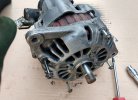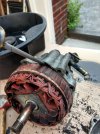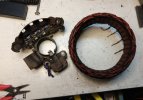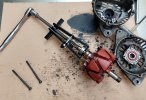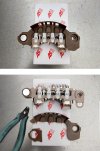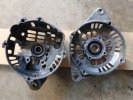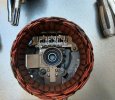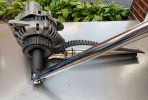Finally got most of the parts together to do a full rebuild of the OEM alternator; parts needed:
Unfortunately, all of these parts are unavailable OEM; so I sourced the highest quality parts I could find (AS-PL europe, and NSK japan bearings). Total parts cost ~ $100-$120.
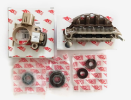
This is really about rebuilding the alternator, but I'll quickly cover the basics of removal/install. First step in removing the alternator is gaining access...
Remove the driver's side engine cover and engine stone shield/bash plate- ~ 15-20 minutes.
Consider removing the radiator... the 30 minutes it takes will make access a lot easier/quicker; and you might wind up removing it anyway. I didn't, and because I didn't, I used a variety of ratchets, extensions, ratcheting box wrenches, and contortions... going back and forth trying to find "the right 12mm combination" wasted a fair bit of time.
Removing the alternator
Next, disassembling the alternator...
- Seals ME700547 (2ea)
- Bearings MD611474, MD611476
- Regulator MD611668
- Rectifier MD611599
- Crush Washers MF660063 (2ea, 4 if replacing the line)
- O-ring ME700951
Unfortunately, all of these parts are unavailable OEM; so I sourced the highest quality parts I could find (AS-PL europe, and NSK japan bearings). Total parts cost ~ $100-$120.

This is really about rebuilding the alternator, but I'll quickly cover the basics of removal/install. First step in removing the alternator is gaining access...
Remove the driver's side engine cover and engine stone shield/bash plate- ~ 15-20 minutes.
Consider removing the radiator... the 30 minutes it takes will make access a lot easier/quicker; and you might wind up removing it anyway. I didn't, and because I didn't, I used a variety of ratchets, extensions, ratcheting box wrenches, and contortions... going back and forth trying to find "the right 12mm combination" wasted a fair bit of time.
Removing the alternator
- Start by disconnecting the battery... just the ground is probably adequate; I disconnected both and covered the positive post (the connection of concern is the alternator fusible link).
- Next, back off the tensioner lock bolt, slack off the tension, and remove the bolt that secures the bracket to the alternator (12mm)... the rest of the work can be done from below.
- If you want more room to work; jack up the front of the van and support it on jack stands (or run it up on ramps before beginning).
- Start disconnecting stuff... beginning with electrical; disconnect the 2 wire plug, the oil pressure light wire next to the alternator, and the single large wire (10mm). If the wire end rotates with the nut, jam a flat bladed screwdriver next to it to prevent the rotation... there is a second 12mm nut behind the wire terminal, but it's about impossible to get a wrench on it. With those 3 connection undone, move the harness out of the way.
(*as a side note... if you find the ubiquitous decayed electrical tape, investigate; I found an exposed solder splice that exists for no apparent reason) - Use a flat bladed screwdriver to push the vacuum lines off (no need to remove the spring clamp first).
- Loosen the locking nut (12mm) on the alternator pivot bolt and remove the belts from the pulley... you can't remove the bolt with the oil return line installed.
- Remove the oil lines (feed banjo 17mm). Stick the end of the feed line up somewhere so it doesn't keep dripping (residual line oil). If either the feed line or return line is hard, or shows any sign of decay, replace it. And if replacing the return line, move the clamps out of the way and cut the line out with a razor knife... it's far easier than fighting with that thing. The vacuum pump will drain some oil, and probably some more at the end when you pull the alternator out.
- Next, remove the pivot bolt. I was able to use a short punch (centered by the backed off nut) and a hammer to drive the bolt back; then I was able to get a flat bladed screwdriver behind the head to pry it out farther, and then pull it the rest of the way out. If it won't move I suggest removing the radiator and using the bearing puller to push it out. Don't have one? Get a $15 puller; you're probably going to need it for the alternator rebuild anyway (or some other task in the future
).
- Pull the alternator out and put it in a container to collect the remaining oil in the vacuum pump.
Next, disassembling the alternator...
Last edited:


